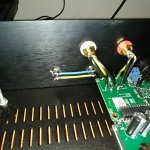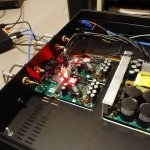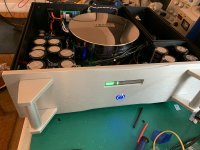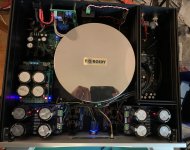I agree, they are overspecified. I bought everything as a bundle from someone that never got around to putting it all together. At this point I’m very tempted to get a pair of Tom’s input buffers to complete the build.
Oh yes, I read this previously...
Tom's buffer looks fine. I tool the Eval2 board as I trust Purifi's team to know their business... I'll see for a valve "option" later this year...
Tom's buffer looks fine. I tool the Eval2 board as I trust Purifi's team to know their business... I'll see for a valve "option" later this year...
Hey...
There is nothing wrong with having two SMPS 1200. In fact the extra power supply headroom might offer a small advantage. I have been considering adding Neurochrome buffers on my build, they look to be excellent. The Neurochrome buffers also drive the input of the Purifi using an OPA which has a bit more current capability than the 1612 used by Purifi, and again, this might offer a slight advantage.
I have one of Tom's HP-2 headlamp boards here now, I can attest the PCB quality both in terms of production and Tom's layout skills.
I agree, they are overspecified. I bought everything as a bundle from someone that never got around to putting it all together. At this point I’m very tempted to get a pair of Tom’s input buffers to complete the build.
There is nothing wrong with having two SMPS 1200. In fact the extra power supply headroom might offer a small advantage. I have been considering adding Neurochrome buffers on my build, they look to be excellent. The Neurochrome buffers also drive the input of the Purifi using an OPA which has a bit more current capability than the 1612 used by Purifi, and again, this might offer a slight advantage.
I have one of Tom's HP-2 headlamp boards here now, I can attest the PCB quality both in terms of production and Tom's layout skills.
There is nothing wrong with having two SMPS 1200. In fact the extra power supply headroom might offer a small advantage. I have been considering adding Neurochrome buffers on my build, they look to be excellent. The Neurochrome buffers also drive the input of the Purifi using an OPA which has a bit more current capability than the 1612 used by Purifi, and again, this might offer a slight advantage.
I have one of Tom's HP-2 headlamp boards here now, I can attest the PCB quality both in terms of production and Tom's layout skills.
Agreed re the headroom although I rarely listen as seriously high levels.
Tom's products are excellent, I've built a preamp using a pair of his buffer boards and have just completed a new power amp using the MODULUS-686 boards.
I have a simple question.. For those using an Eval (1 or 2) board, do you stick with the provided connectors or switch to more "fancy" one ?
If the latest, what are you doing for the sense +/- ad is it that important ? (sorry if it's an obvious question...)
If the latest, what are you doing for the sense +/- ad is it that important ? (sorry if it's an obvious question...)
I...
My build does not use the Eval mounted connectors. I used panel mounted WBT binding posts and Neutrik XLRs with metal shells. I used 2x16 AWG wire for speaker connections of less than 3" for an aggregate gauge of 13. I jumped the sense wiring on the board for simplicity. With output wiring of this short length, and high gauge, I very much doubt there would be any difference extending the feedback loop to the speaker terminals, but it is your choice to do so, or not as you see fit.
I have a simple question.. For those using an Eval (1 or 2) board, do you stick with the provided connectors or switch to more "fancy" one ?
If the latest, what are you doing for the sense +/- ad is it that important ? (sorry if it's an obvious question...)
My build does not use the Eval mounted connectors. I used panel mounted WBT binding posts and Neutrik XLRs with metal shells. I used 2x16 AWG wire for speaker connections of less than 3" for an aggregate gauge of 13. I jumped the sense wiring on the board for simplicity. With output wiring of this short length, and high gauge, I very much doubt there would be any difference extending the feedback loop to the speaker terminals, but it is your choice to do so, or not as you see fit.
I must confess I dont see what this "sense" thing is so it's hard to have an opinion 😱
Thanks for the feedback !
Thanks for the feedback !
they...
The sense wires basically extend the feedback loop. With the eval board in stock mode, the feedback loop includes up to the speaker connections. If you run small gauge speaker wires to a binding post, then the run the sense wires also to the binding post, the feedback loop would then correct for any additional impedance of the small gauge wires, which might affect the damping factor of the amp (output impedance).
But if one just runs relatively large gauge, relatively short wires, to the speaker binding posts, there will not be any significant added impedance, and so no need to extend the feedback loop around the wires as well. Just make sure when you remove the Eval Boards speaker connectors, that you also jump the sense wire points, as mentioned in the user guide for the Eval board, as this closes the feedback loop on the board. If you do not do this, you will have big problems running the output of the amp without feedback!
The sense wires basically extend the feedback loop. With the eval board in stock mode, the feedback loop includes up to the speaker connections. If you run small gauge speaker wires to a binding post, then the run the sense wires also to the binding post, the feedback loop would then correct for any additional impedance of the small gauge wires, which might affect the damping factor of the amp (output impedance).
But if one just runs relatively large gauge, relatively short wires, to the speaker binding posts, there will not be any significant added impedance, and so no need to extend the feedback loop around the wires as well. Just make sure when you remove the Eval Boards speaker connectors, that you also jump the sense wire points, as mentioned in the user guide for the Eval board, as this closes the feedback loop on the board. If you do not do this, you will have big problems running the output of the amp without feedback!
Got my EVAL2 from purifi yesterday my setup also will be a 3 channels.
But I will not suffer any problems from splitting the DC output nor the AUX.
Everything is plug and play with the SMPS1K-PFC plus the splitting pcbs.
Will post pictures when ready.
But I will not suffer any problems from splitting the DC output nor the AUX.
Everything is plug and play with the SMPS1K-PFC plus the splitting pcbs.
Will post pictures when ready.
Last edited:
Thanks a lot Barrows, I get it...
I am curious, what if we added a cable up to the speaker, would that make sense ? I guess there is a catch for sure but...as said, I am curious 🙂
I am curious, what if we added a cable up to the speaker, would that make sense ? I guess there is a catch for sure but...as said, I am curious 🙂
Other question, I am preparing my cabling a discover that the SMPS600 is not "just" a smaller version of the SMPS1200.
I spotted 2 differences (and stopped to write here):
- The VDR (Bootstrap Driver Voltage) output of the SMPS600N400 is 17V where the Purifi EVAL2 is expecting 15V (max 16.5V) according to the specs. I guess this means I should add a regulator to step down to 15V (correct) ?
- Another point, there is no interface output (like Amp Enable). Is it a problem ? Do I need to provide for those signal on my own ?
I spotted 2 differences (and stopped to write here):
- The VDR (Bootstrap Driver Voltage) output of the SMPS600N400 is 17V where the Purifi EVAL2 is expecting 15V (max 16.5V) according to the specs. I guess this means I should add a regulator to step down to 15V (correct) ?
- Another point, there is no interface output (like Amp Enable). Is it a problem ? Do I need to provide for those signal on my own ?
The absolute max spec for the gate drive is 20V, so you could probably get away with 17V. If you wanted to drop it a bit, the typical current is only 35ma, so a diode or two in series might work ok.
I'm not sure how the SMPS600N400 voltages come up, but you can probably get away with just grounding the /AMPON signal.
Taking the sense signals all the way to the speakers would provide the best feedback, but you risk the possibility of turning the amp on by accident with nothing connected. Another option would be to add the external sense lines, but use a 1R jumper inside the chassis just in case.
I'm not sure how the SMPS600N400 voltages come up, but you can probably get away with just grounding the /AMPON signal.
Taking the sense signals all the way to the speakers would provide the best feedback, but you risk the possibility of turning the amp on by accident with nothing connected. Another option would be to add the external sense lines, but use a 1R jumper inside the chassis just in case.
Ok, this is what I did with my ncore a long time ago, but I prefer to be sure..
Thanks a lot..
I do not plan to add this external sense, I was more wondering why nobody was doing it 😉
Thanks a lot..
I do not plan to add this external sense, I was more wondering why nobody was doing it 😉
I'm late to the party....
Wanted to finally try a modern class d amp and 1et400a looks good.
Been using VFET amps for a while (Yamahas and a Sony) so this will be interesting!!!
Please recommend a buffer board that will be... how shall I state this... not too bright and dry sounding. I'm gonna say it 🙂 textural sound -- unlike my old Spectron class d, the one I sold.
Thanks!
Wanted to finally try a modern class d amp and 1et400a looks good.
Been using VFET amps for a while (Yamahas and a Sony) so this will be interesting!!!
Please recommend a buffer board that will be... how shall I state this... not too bright and dry sounding. I'm gonna say it 🙂 textural sound -- unlike my old Spectron class d, the one I sold.
Thanks!
@eboissier - I am building a Purifi-based amp (monoblocks) with a linear power supply. I have one channel complete and currently am just grounding the /AMPON signal. There is a slight (half-second, low volume) buzz when power is first applied, but this is barely noticeable.
Ideally, a circuit that clamped this signal after a couple seconds would be better, and I plan to implement this on the custom buffer board I am working on.
For now, I am using the Neurochrome input buffer. Since I only have one channel implemented and don't have the amp in my main system, I can't fully assess the sound yet, but it seems to sound quite nice driving my workshop speakers (Totem Mani-2).
Ideally, a circuit that clamped this signal after a couple seconds would be better, and I plan to implement this on the custom buffer board I am working on.
For now, I am using the Neurochrome input buffer. Since I only have one channel implemented and don't have the amp in my main system, I can't fully assess the sound yet, but it seems to sound quite nice driving my workshop speakers (Totem Mani-2).
Thanks Jaytor..
I am currently going with the Eval2, I let you know what's happening on my side
I am currently going with the Eval2, I let you know what's happening on my side
My amp is coming around nicely. It makes music already and Eval1 is switching on and off nicely with mains on smps1200.
I have a question on smps standby:
I have added an 12V input and output in parallel (see detailed picture). I plan to connect the 12V adapter of my streamer to the input. 12V output will go to said streamer.
The 12V plus I plan to connect to a switch on the face plate and then to J5.1 (smps standby). When the switch is connected position the smps1200 will switch off. When the switch is disconnected the smps1200 will switch on.
What to do with 12V GND wire? Should I connect it to GND of the smps1200 or GND of the housing or doesn't it need to be connected to the amp at all? I'm a bit afraid of humming when connecting amp GND with 12V adapter GND.

I have a question on smps standby:
I have added an 12V input and output in parallel (see detailed picture). I plan to connect the 12V adapter of my streamer to the input. 12V output will go to said streamer.
The 12V plus I plan to connect to a switch on the face plate and then to J5.1 (smps standby). When the switch is connected position the smps1200 will switch off. When the switch is disconnected the smps1200 will switch on.
What to do with 12V GND wire? Should I connect it to GND of the smps1200 or GND of the housing or doesn't it need to be connected to the amp at all? I'm a bit afraid of humming when connecting amp GND with 12V adapter GND.


Last edited:
- Home
- Amplifiers
- Class D
- Brainstorming Purifi 1et400a amps

